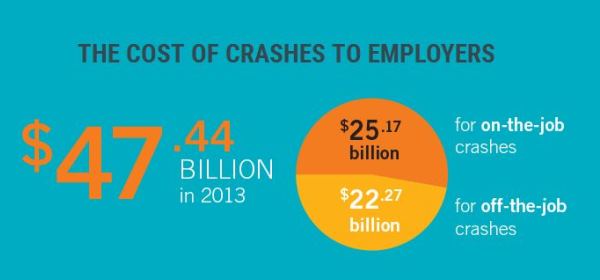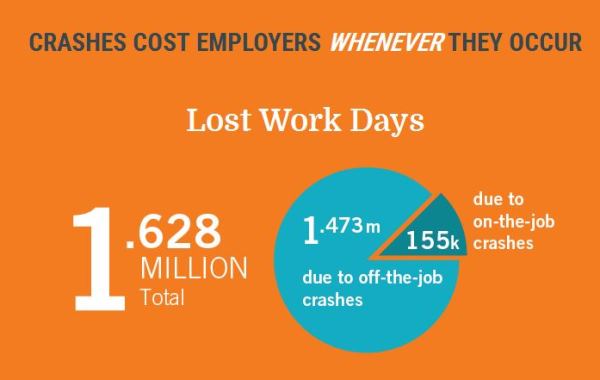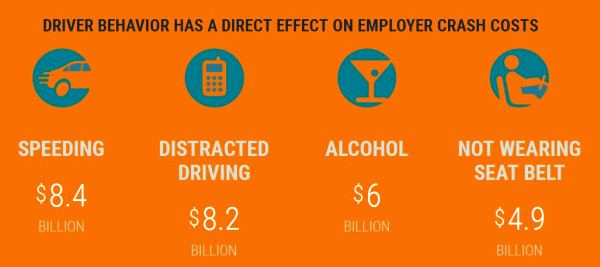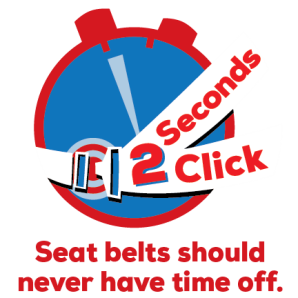Motor vehicle crashes are a significant source of loss to employers, in terms of lives lost and high dollar costs. Investing in safety can yield big returns.

Images and statistics courtesy of the Network of Employers for Traffic Safety
According to a recent report by the Network of Employers for Traffic Safety:
- In 2013, motor vehicle crashes killed more than 1,600 on-the-job workers and injured 293,000
while they were working - Motor vehicle crash injuries on and off the job cost employers $47.4 billion in 2013
- One quarter of this cost resulted from off-the-job injuries to workers and their dependents
- On-the-job highway crashes cost employers $24,000 per crash, $45,000 per million vehicle-miles of travel and $68,000 per injury
- Costs per employee vary by state, but were highest in Louisiana ($560), Montana ($620), and West Virginia ($510) and lowest in Colorado ($180), Iowa ($150), Minnesota ($190), Washington ($190) and Wyoming ($140)
- Lack of seat belt use alone incurs $5 billion in annual costs to U.S. employers
- It’s not just about your employees: 172,994 bystander related persons were injured in 2013
- Investing in road safety can reduce your crash rate by 50% or more.

Download the full report from Network of Employers for Traffic Safety Cost of Motor Vehicle Crashes to
Employers – 2015. The report includes Costs per state, costs per industry, and costs by selected risk factors, including some of the biggest cost drivers:
- Non-seat belt use
- Alcohol use
- Distracted driving
- Speeding

The report notes that:
“Employer costs resulting from motor vehicle crashes fall into two categories: health fringe benefit costs and non-fringe costs.
Health fringe benefit costs are the costs of fringe benefits paid because of illness and injury of employees and their dependents. They cover contributions to Workers’ Compensation medical and disability insurance, health insurance, sick leave, Social Security disability insurance, life insurance and private disability insurance, as well as insurance administration and overhead.
Non-fringe costs include motor vehicle property damage and liability insurance, crash-related legal expenses and the costs of unreimbursed vehicle damage and replacement. In addition, employers pay taxes to help fund police fire, and ambulance services. Employers also lose productivity when employees suffer injuries preventing them or their coworkers from working at full capacity. Recruiting and training workers to replace fatally injured or permanently disabled employees raises the bill employers pay for injuries.”
NETS, or the Network of Employers for Traffic Safety has numerous tools, promotions and resources to help employers initiate workplace safe-driver programs.
One current program is the 2Seconds 2Click campaign. It is designed to address the fact that nationwide, half of the people killed in motor vehicle crashes last year weren’t wearing their seat belts. It’s modeled on a program that Coca-Cola Refreshments of Bismarck, ND piloted as a 6-week workplace campaign to encourage its employees to buckle up on every trip.
We encourage employers to have a safe driving policy, both for those employees who have work-related driving responsibilities as well as those who don’t. A policy might include such provisions as:
- Safe driver training programs
- Specialized training for drivers with safety-sensitive responsibilities
- Statement of expectations on safe, courteous driving
- Mandatory seat belt use for drivers and passengers
- Annual proof of a valid driver’s license
- Policies on distracted driving, particularly cell-phone use and texting
- Policies on drug and alcohol use
- Requirement that any on-the-job accidents and moving violations be reported immediately
- Requirement that off the job accidents and moving violations be reported within a week
Here are additional resources on work-related driving safety
- OSHA: Motor Vehicle Safety
- NIOSH: Work-Related Roadway Crashes: Prevention Strategies for Employers
- OSHA: Safe Driving Practices for Employees
- SHRM: Vehicle Safety: Company Fleet Usage and Driver Safety Policy
- OSHA: Guidelines for Employers to Reduce Motor Vehicle Crashes
Related: Ask about ESI EAP’s Drug Free Workplace and DOT Compliance Program.

